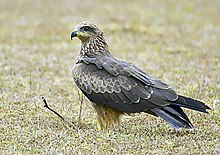Black kite
| Black kite | |
|---|---|
 |
|
| M. m. govinda, India | |
| Scientific classification | |
| Kingdom: | Animalia |
| Phylum: | Chordata |
| Class: | Aves |
| Order: | Accipitriformes |
| Family: | Accipitridae |
| Genus: | Milvus |
| Species: | M. migrans |
| Binomial name | |
|
Milvus migrans (Boddaert, 1783) |
|
| Subspecies | |
|
5, see text |
|
 |
|
| Range of black and yellow-billed kites Northern summer range Year-round range Southern summer range | |
| Synonyms | |
|
|
5, see text
The black kite (Milvus migrans) is a medium-sized bird of prey in the family Accipitridae, which also includes many other diurnal raptors. It is thought to be the world's most abundant species of Accipitridae, although some populations have experienced dramatic declines or fluctuations. Current global population estimates run up to 6 million individuals. Unlike others of the group, black kites are opportunistic hunters and are more likely to scavenge. They spend a lot of time soaring and gliding in thermals in search of food. Their angled wing and distinctive forked tail make them easy to identify. They are also vociferous with a shrill whinnying call. This kite is widely distributed through the temperate and tropical parts of Eurasia and parts of Australasia and Oceania, with the temperate region populations tending to be migratory. Several subspecies are recognized and formerly had their own English names. The European populations are small, but the South Asian population is very large.
Black kites can be distinguished from red kites by the slightly smaller size, less forked tail (visible in flight), and generally dark plumage without any rufous. The sexes are alike. The upper plumage is brown but the head and neck tend to be paler. The patch behind the eye appears darker. The outer flight feathers are black and the feathers have dark cross bars and are mottled at the base. The lower parts of the body are pale brown, becoming lighter towards the chin. The body feathers have dark shafts giving it a streaked appearance. The cere and gape are yellow, but the bill is black (unlike in the yellow-billed kite). The legs are yellow and the claws are black. They have a distinctive shrill whistle followed by a rapid whinnying call. Males and females have the same plumage but females are longer than males. Their wingspan is around 150 cm.
The scientific name is derived from Latin. The genus name Milvus was the name of the red kite in that language, and migrans meant migrating, from migrare "to migrate".
The red kite has been known to hybridize with the black kite (in captivity where both species were kept together, and in the wild on the Cape Verde Islands).
...
Wikipedia

